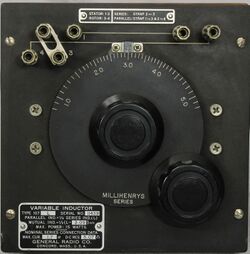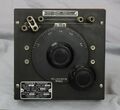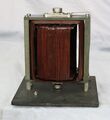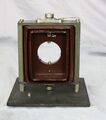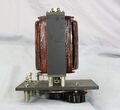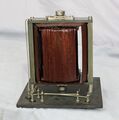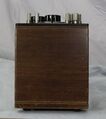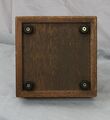107-L: Difference between revisions
Jump to navigation
Jump to search
No edit summary |
No edit summary |
||
| Line 27: | Line 27: | ||
* '''DC Resistance:''' 5 Ω | * '''DC Resistance:''' 5 Ω | ||
* '''Maximum Power:''' 15 W | * '''Maximum Power:''' 15 W | ||
==Links== | ==Links== | ||
* [[Media:GR Exp 107 06_1932.pdf|Experimenter June 1932 describing Type 107 Series]] | * [[Media:GR Exp 107 06_1932.pdf|Experimenter June 1932 describing Type 107 Series]] | ||
* [[Media:GR Exp 107 01_1935.pdf|Experimenter January 1935 describing Type 107 Series]] | * [[Media:GR Exp 107 01_1935.pdf|Experimenter January 1935 describing Type 107 Series]] | ||
{{107 Series}} | |||
==Photos== | ==Photos== | ||
Revision as of 05:14, 4 May 2024
The General Radio 107-L Variable Inductor was introduced in Catalog H (1935) and remained available through Catalog T (1968).
The Type 107-L is a variable inductor or "Variometer" of the Ayrton–Perry winding design. It contains two circular coils arranged within one another, a stator or fixed coil and a rotor coil attached to a calibrated inductance dial. By changing the orientation of the rotor coil, inductance can be varied. The leads of the two coils are brought out to four binding posts where connections determine series, parallel or mutual inductance settings. Shorting links are provided for this purpose. The 107-L featured a Bakelite panel and walnut case. A tag attached to the panel displays the actual values.
Specifications
- Self-Inductance Series: 0.9 to 5 mH
- Self-Inductance Parallel: 0.225 to 1.25 mH
- Mutual-Inductance: 0 to 1.1 mH
- Accuracy: 1%
- Maximum Current: 1.7 A
- DC Resistance: 5 Ω
- Maximum Power: 15 W
Links
- Experimenter June 1932 describing Type 107 Series
- Experimenter January 1935 describing Type 107 Series
|
